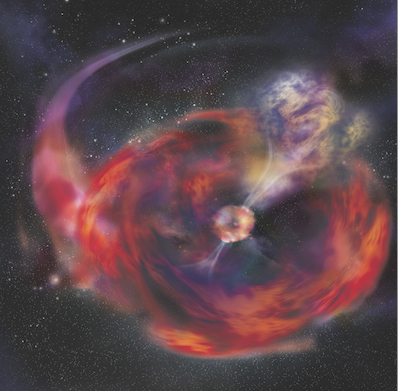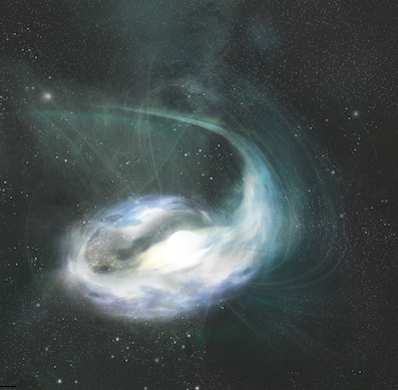
A cosmic explosion with a dual personality
DR EMILY BALDWIN
ASTRONOMY NOW
Posted: 02 December 2011


A curious cosmic explosion that detonated on Christmas Day last year could be explained by either a novel type of supernova billions of light years away, or the collision of a large comet-like object with a neutron star closer to home, say two different teams of scientists reporting their results in the journal Nature this week.
The explosion, nicknamed the "Christmas burst" but more formally identified as GRB 101225A, was first picked up by NASA's orbiting Swift Observatory in the constellation Andromeda, triggering an alert to telescopes around the world – including the UK's Liverpool Telescope in the Canary Islands – that tracked the unusual set of events as they unfolded.

Optical emission connected to GRB 101225A at different epochs. The last panel shows the deep image of the host galaxy. Image: Christina Thoene et al.
GRBs are the death cry of a star many times greater in mass than our Sun as it collapses under its own weight after exhausting its fuel supply, compressing into a dense city-sized neutron star or a black hole. Short gamma-ray bursts are characterised by a brief, less than two second burst of high energy gamma rays before subsiding, while longer-duration bursts last for several tens of seconds. But GRB 101225A sounded its horn for an impressive 28 minutes, and was accompanied by a hot thermal component.
Follow-up observations with both the Hubble Space Telescope and a suite of ground-based telescopes were unable to pinpoint its distance, however.
“The fact that in the same GRB we see no classical afterglow, a hot thermal component, an unprecedentedly dim supernova explosion, and extremely long activity in gamma-rays alerted us about the very peculiar nature of this GRB,” says Antonio de Ugarte Postigo from the Instituto de Astrofisíca de Andalucía, who co-authors one of the papers featured in the 1 December issue of Nature.

Artist's impression of the generation of a GRB through the merger of a red giant and neutron star, and the subsequent generation of a black hole. Image: Aurore Simonnet, NASA E/PO, Sonoma State University.
De Ugarte, lead author Christina Thoene and their other co-authors propose that the burst originated from an exotic binary system comprising a neutron star orbiting a red giant that had puffed up its outer layers so much as to consume its neighbour. Such a dramatic merger event triggered the formation of a black hole and the production of GRB-like jets. This was followed by a weak supernova event 10 days later where a faint light source appeared to brighten.
The scientists have detected what might be a faint host galaxy in the right location, some 5.5 billion light years away.
Meanwhile, Sergio Campana of the Brera Observatory in Merate, Italy, leads an alternative theory that the tidal disruption of a comet-like object – perhaps half the mass of dwarf planet Ceres – and its subsequent stream of debris crashing into a neutron star, could provide the same results.
"We believe that the strong variations that can be observed in the early X-ray light curve are the signature of the disruption of the colliding object and disc formation process," Campana tells Astronomy Now.

Artist's impression of the tidal disruption of a minor body by a neutron star that leads to gamma-ray emission. Image: A. Simonnet, NASA, E/PO, Sonoma State University.
In this model, gamma-ray emission results from debris falling onto the neutron star, swirling around the host in clumps. X-ray variations detected by Swift are attributed to further clumps of material striking the star as the disc formed around it. The neutron star in this model would only need to be 10,000 light years away to notice these effects.
"This should not be an unique event; now that we know its characteristics we can try to find similar events in the archives or in new dedicated surveys," continues Campana. "We are going to search for a radio pulsar (a different manifestation of a neutron star) and we are asking for a deep observation in X-rays. If we will find something then it will be a good point in favour of our model, but if nothing is found both models will remain viable."
“What the Christmas burst seems to be telling us is that the family of gamma-ray bursts is more diverse than we fully appreciate,” adds Thoene. “Stars seem to find many different ways of how to die.”
|



